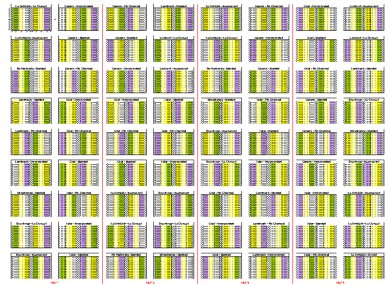THE HERBICIDE AND CHARCOAL TREATMENT TRIAL

Figure 1. Experimental design of the Herbicide and Charcoal Treatment Trial. Note: clicking on the image will take you to a large image of the trial layout.
Overview
The Herbicide and Charcoal Treatment Trial (Figure 1), and its "sister study", the Seed Augmentation and Planting Method Trial, represent a collaborative effort among the US Bureau of Reclamation (Ken Lair, BOR; Technical Service Center, Denver; and Land Retirement Program, Fresno), the Endangered Species Recovery Program, Dr. Joe DiTomaso (University of California, Davis; UCD), and the Lockeford Plant Materials Center (Dave Dyer, USDA-NRCS; Lockeford) to conduct research addressing native plant community establishment on cropland dewatered through acquisition of water rights ("land retirement") by BOR and/or Westlands Water District (WWD). The two studies have been implemented as part of the research thrust of the Land Retirement Demonstration Project (LRDP), implemented under the authority of the California Central Valley Project Improvement Act (CVPIA).
The research involves evaluations of species suitability (with implications for mixture formulation), species propagation and seed increase, seed conditioning, seed harvest and planting methods, soil amendments, and weed control. Study objectives emphasize subsequent development of revegetation prescriptions for land owners throughout WWD, with emphasis on restoration of native shrub/forb and salt desert scrub plant communities that a) enhance habitat values for endangered species (e.g., kit fox, giant kangaroo rat); b) provide livestock grazing resources compatible with habitat goals; and c) result in site stabilization and weed suppression.
Introduction
Weed control remains the overriding limitation of restoration on LRDP retired (dewatered) lands. Chemical methods of weed control exacerbated can be particularly problematic because most potential herbicide choices exhibit activity on the seeded non-target species (i.e., seeded species). Other IPM strategies such as grazing, fire and mechanical control are being evaluated, but have limited utility or windows of opportunity during seeded species establishment periods. Selective, pre-emerge herbicides with longer residual activity in conjunction with native seed / seedling safeners are needed to maximize this establishment window. A primary objective of the study is to determine if significant levels of control can be achieved using only natural precipitation to activate and move the herbicides into the root zone of the dominant weeds, with the activated charcoal serving as a protectant for the seeded natives. If one of the EUP herbicides should prove more effective than other herbicide options, a special local need permit may be pursued for its broader-scale use within the CVPIA-Land Retirement project, since 70,000-100,000 acres within the project may eventually be targeted for revegetation.
In a replicated [6x3] factorial study (0.9 ha; installed December 13-16, 2004), four seeded native forb and shrub species (Table 1) were drilled without protectant safener (control) or precisely within an incorporated powder band or beneath an over-sprayed slurry band of activated charcoal (Gro-SafeŽ; Norit Americas; applied at 336 kg ha-1) to protect them from pre-emerge herbicides applied broadcast by ground rig. This weed management approach is commonly and successfully practiced in ryegrass and turfgrass industries, with possibilities for extension to drilled applications of native species. Six pre-emerge herbicide treatments (no herbicide [control], Landmark MP®, Telar DF®, Goal 2XL®, Broadrange®, and Cerano 5MEG® [the latter two of which are evaluated under an Experimental Use Permit; EUP]), compare potential control of a mixed composition of black mustard (Brassica nigra), London rocket (Sisymbrium irio), and the "tumbling saltbushes"(Atriplex rosea and A. argentea). Initial monitoring for seeded species emergence and survival will commence April 25, 2005.
It is anticipated that a similar study will be undertaken on the North Avenue Parcel in the 2005-06 growing season. This study will be situated in an area dominated by cool-season introduced grasses (Hordeum murinum, Bromus madritensis, Avena spp.), and will receive similar herbicide and activated charcoal treatments.
Table 1. Species planted in the Herbicide and Charcoal Treatment Trial, Tranquillity site 2004-05.
| Taxon | Family | Common Name | Life-form |
|---|---|---|---|
| Atriplex polycarpa | Chenopodiaceae | allscale saltbush | shrub |
| Grindelia camporum | Asteraceae | gumplant | perennial herb |
| Phacelia ciliata | Hydrophyllaceae | Great Valley phacelia | annual herb |
| Suaeda moquinii | Chenopodiaceae | bush seepweed | sub-woody perennial |
Page created: March 1, 2005; Last updated: Dec. 20, 2005